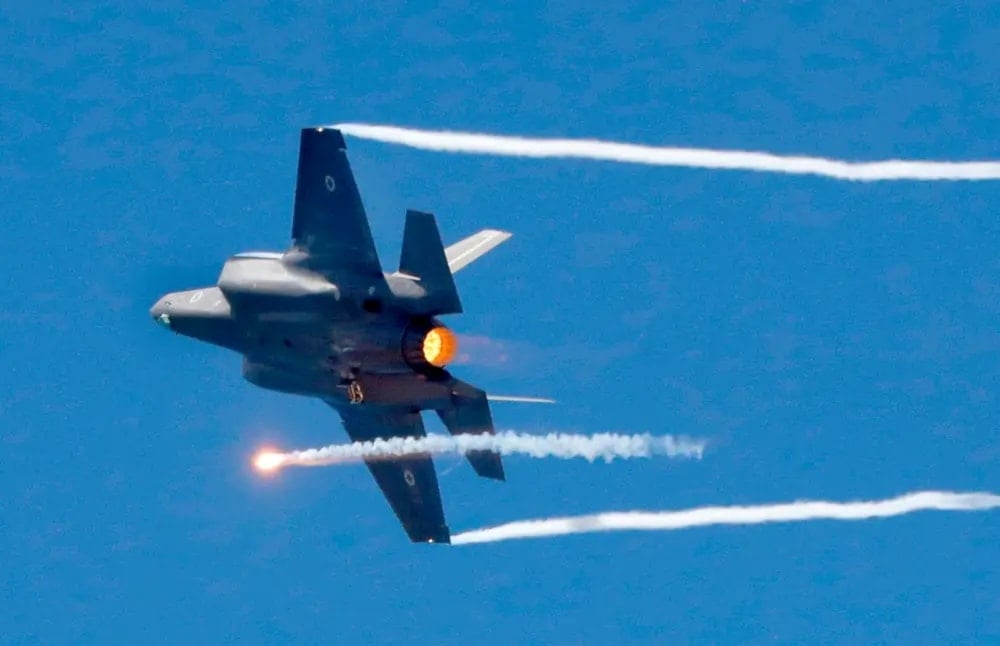Did 'Israel' modify F-35 jets to strike Iran without re-fueling?
Analysts interviewed by the National Interest question whether “Israel’s” F-35I Adir jets have been secretly upgraded to strike deep into Iran without mid-air refueling.
-

An Israeli F-35I Adir fighter jet appears in this undated photo (Jack Guez/AFP)
According to a recent article by The National Interest, as “Israel’s” campaign of strikes against Iran intensifies, defense analysts are raising questions about the range capabilities of the Israeli Air Force’s (IAF) fleet of F-35I Adir fighter jets.
Given the distance between occupied Palestine and Iranian strategic targets, some experts believe “Israel” may have modified the jets to eliminate the need for midair refueling.
The question of how these aircraft are reaching deep into Iranian airspace has become more pressing as both sides escalate their military operations. While the Israeli occupation relies heavily on advanced missile defense systems such as the Iron Dome, Arrow 2/3, and David’s Sling, its offensive capabilities increasingly hinge on the performance of the F-35I Adir, according to The National Interest.
Following a string of precision airstrikes targeting Iranian nuclear and military assets, observers have begun to question whether the IAF’s Adir jets have undergone range-extending upgrades. These concerns are driven by logistical realities: the IAF possesses only seven Boeing 707 refueling tankers, a relatively small fleet for sustained long-range air operations.
As reported by The National Interest, in 2022, the Israeli Air Force has reportedly claimed that its F-35I fleet could reach Iran without refueling. However, no technical details were disclosed, fueling speculation that the Adirs may have undergone covert modifications.
“Israel” became the first country outside the core development group to acquire the F-35 Joint Strike Fighter in the early 2010s. Its version, dubbed the “Adir” or “Mighty One,” has operated since 2017 and features a number of localized upgrades, according to The National Interest.
Among these are a domestically developed electronic warfare system, a unique helmet-mounted display, and mission systems tailored to “Israel’s” operational needs. Crucially, the IAF is permitted to modify its aircraft externally, an allowance not granted to most other F-35 operators.
Could range-enhancing modifications be behind extended missions?
The standard F-35 has a range of approximately 1,350 miles and a top speed of Mach 1.6. While that range could theoretically allow it to reach western Iran, consistent operations against multiple targets would require extended endurance.
As reported by The National Interest, analysts suggest that the Adir may have been equipped with additional fuel tanks or undergone internal software optimizations that enhance fuel efficiency. Some speculate that new stealth-compatible fuel pods may be in development, although no official confirmation exists.
As noted by The Aviationist, “In 2022 the Israeli Air Force made claims that its F-35 fleet was now capable of reaching Iran without refueling. It made no clarifying statements at the time about how exactly they had achieved this,” as reported by The National Interest.
Given the limited number of air tankers in the IAF’s inventory, long-range F-35 missions present a challenge. This has led military aviation analysts to assume that either additional refueling assets are being used covertly, or the aircraft themselves have been modified in secret.
With “Israel’s” strike campaign showing no signs of slowing and targets located deep within Iranian territory, questions about the true capabilities of the Adir fleet are likely to persist, according to The National Interest.

 3 Min Read
3 Min Read









